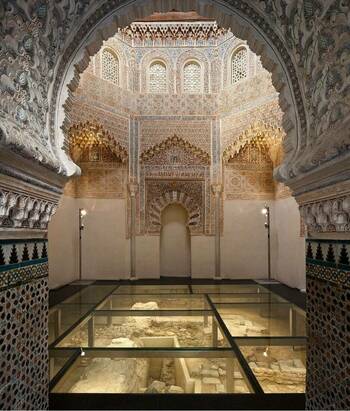From the Medieval Research Blog: "The Nasrid College: Trade and Multiculturalism in a Medieval Islamic City-State"

For Spain and North Africa, the late medieval period (ca. 1250-1500) was a tumultuous era that was characterized by political turmoil and mass violence. It was also the period that witnessed one of the greatest bursts of cultural efflorescence, intellectual creativity and administrative-political innovation in the region. During the fourteenth and fifteenth centuries, the cities of Toledo, Seville, Granada, Fez and Tunis, not unlike the city-states of Renaissance Italy during the same period, produced some of the most remarkable scholars and intellectuals in the history of the Western Mediterranean, despite the numerous challenges of the era. It was also the period that witnessed the rise of some of the most remarkable pieces of architecture in the region. One of the most iconic monuments associated with this period is the Alhambra, the royal and administrative center of the Nasrid kingdom of Granada between the 13th and 15th centuries. Since the Middle Ages, there has been no shortage of interest in this palace-fortress complex, its monumental scale and its exquisite craftsmanship.
The history of another architectural and cultural gem from 14th-century Granada, which remains relative little-known beyond a small circle of specialists, is concealed behind an 18th-century Baroque façade behind the Great Cathedral of Granada: the Nasrid College (al-madrasah al-naṣriyyah), constructed in April 1349.
The Nasrid College was a rare example of a madrasah constructed in medieval al-Andalus (Muslim Iberia). This structure, which was only excavated and restored over the past several decades and finally opened to the public in 2011, provides important insights into the intellectual, social and political history of Nasrid Granada during the 14th century.
This short post seeks to provide an overview of the emergence of the Nasrid College, with particular attention to the cultural, political and intellectual context in which it emerged.
Nasrid Granada, the last surviving Muslim polity in medieval Iberia, was a borderland city-state entrenched in the farthest reaches of the Islamic world, between Europe and North Africa, yet closely connected and integrated within both Latin Christendom and the Islamic world. The Muslim-Christian borderlands during this period were characterized by intermittent frontier warfare and shifting alliances between Nasrid and Castilian rulers, the emergence of a bilingual nobility (conversant in Romance as well as Arabic), and the permeability of the frontier, which facilitated the passage and migration of mercenaries and merchants, renegades and refugees, scholars and slaves between the Islamic world and Latin Christendom.
This is an excerpt from "The Nasrid College: Trade and Multiculturalism in a Medieval Islamic City-State" written by Dr. Mohamad Ballan (Assistant Professor of History at Stony Brook University and former Mellon Fellow at the MI for the academic year 2021-2022). Read the full story (and check out Part II as well!).